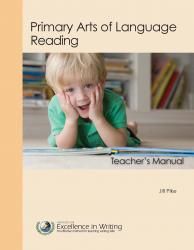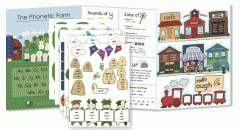
We have been struggling with reading lately...ok for a while. Lydia is just not grasping it, she gets frustrated and then gives up. She loves being read to, but does not really want to learn to read. It has been an ongoing battle.
To be very honest, I just didn't know what direction to turn to. We got the wonderful privilege of receiving Primary Arts of Language Reading and Writing system from Institute for Excellence in Writing. I wasn't sure how she would handle this. After all, there's no fancy bells or whistles. No flashy colors or singing cartoon characters. Nothing on the computer, just good old-fashioned one-on-one working together. After fighting for well over a year now to find a program, and trying so many different ones.....could this be the answer????
Primary Arts of Language Reading Package ($69.00) page:
Using poetry, the reading portion of the Primary Arts of Language teaches phonics and whole words. Students are introduced to letters through letter stories and discover the vowel and consonant pairs that help us read. Daily games played during “Activity Time” reinforce the phonetic concepts so that a student can know them completely.
- Includes the following:
- Instructional Video by Jill Pike
- The Four Language Arts MP3 Audio by Andrew Pudewa
- Nurturing Competent Communicators MP3 Audio by Andrew Pudewa
- Poetry as an Integrator MP3 Audio by Anna Ingham
- Intro to the Blended Sound Sight Program MP3 Audio by Anna Ingham
- Primary Arts of Language: Reading Student Book (e-book)
The entire program is laid out in "parent-friendly" format. If you still are unsure, there are videos that you can watch to explain more about the program and how to set it up.
Primary Arts of Reading is meant to be used together with the Primary Arts of Language writing program, to cover both your language arts and writing programs.
Primary Arts of Language ($89.00) from their site:
The writing portion of Primary Arts of Language, which is divided into three parts: printing, copy work, and composition, should be used concurrently with the reading portion unless your child is already reading. Then you can use these lessons independently. Spelling is included throughout the course.
The printing section provides an entire handwriting program to teach your student how to correctly form his letters—he will learn his letter sounds as he learns to write them. The copy work exercises will make printing automatic in preparation for the composition lessons, which will gently teach your student to write stories and paragraphs with style.
The printing section provides an entire handwriting program to teach your student how to correctly form his letters—he will learn his letter sounds as he learns to write them. The copy work exercises will make printing automatic in preparation for the composition lessons, which will gently teach your student to write stories and paragraphs with style.
This package includes:
- Includes the following:
- Instructional Video by Jill Pike
- Reading Comprehension MP3 Audio by Adam Andrews
- Dictation, Narration, and Public Speaking MP3 Audio by Andrew Pudewa
- The Four Language Arts MP3 Audio by Andrew Pudewa
- Primary Arts of Language: Writing Student Books (e-book)
- Units 1 & 2 in the K–2 Classroom MP3 Audio by Shirley George
- Unit 3 in the K–2 Classroom MP3 Audio by Shirley George
- Preparing the K-2 Writing Environment MP3 Audio by Richelle Palmer
Again...you are not left hanging. There are plenty of resources to help you if you are not sure.
To be honest though....even with watching the videos I was really overwhelmed in the beginning. Partly because there was so much material and partly because of my own fear of Lydia never being able to read on her own. We have been through so much in the past year, I really had my doubts.
But even with the doubts, I got busy arranging the program in our school schedule. This is a type of program that you can use as fast or slow as you need too. I, of course, went into overdrive....and realized very quickly that it was not going to work if she was getting frustrated with so much new thrown at her at once. So I figured out a good schedule for her. Instead of a new lesson daily, we do 2-3 a week depending on how well she is grasping the new sound or concept.
This seems to be working better having review days mixed into the week. Now I mentioned earlier that there are no flashy computer screens or beeping games, and that is true. But there are some wonderful concepts for the kids to learn through games. Your Primary Arts of Language Reading program includes a Phonetic Games book.
These easy to put together games are a great way to reinforce the lessons that the kids are doing. They can be played during lesson time or later in the day as reinforcement. We have used them both ways.
I have not put together all the games yet. I have been doing so many at a time. They are all bound together and clearly marked with instructions in their book. I took the advice from the video to work on them in the evening as we are watching TV.
I have them arranged in a file box that I keep under the edge of our school table. They are all clearly marked, so I just grab the ones that are suggested in our lesson plan for that day.
This is the game for Magic-E.
Also included the Primary Arts of Language: Reading Package is The Phonetic Farm.....
This folder of phonetic rules helps give a visual to the kids. As we learn a new rule, you add the sticker. We keep this with our file folder games, so that we can review them each day.
The stickers store nicely in the folder until we are ready to use them. But this sturdy folder stands up to the kids opening and closing daily. We actually are considering hanging it up with thumb tacks so that we can see it while we work too.
Reading seems to be clicking for Lydia finally. She still struggles, like most kids. We are moving forward through the program at her speed.
This is how we work with the program each day. The night before I read what I need to have prepared (or sometimes while she is working on another project). Each day she takes our her daily journal, which is currently her special drawing place. While she is making an entry in her journal, I read her the assigned poem.
We discuss the sounds or words that are highlighted that day (all of which is included in the lesson plan). You can see she has used a highlighter to mark the sound we were working on. The -ue and the -ee (squeely ee's).
We complete any worksheets and sentence reading pages. This is one of her pages....you can view sample pages from the student workbook here.
And we also include some fun reading in at the end of each lesson. Or we read our American Girl books then. One day I was really struggling to get her to focus and read a Justin Bieber biography book to her.
On average we spend roughly 30 minutes, sometimes a little more or a little less depending on her willingness to work on her Reading.
I do not always do the Primary Arts of Language: Writing at the same time. Lydia knows how to form her letters, and after her journal she generally gets frustrated at doing too many worksheets or writing at one time. So we do the copywork at a different point in the day, or the review day is the day she works on her copywork. This helps to alleviate her frustration...and to be honest mine too. These are examples of the letter writing sheets and copywork.
The program has so many safety nets in place for parents who are nervous about teaching phonics and reading to their children. My lessons are laid out, so it helps me even if I am feeling nervous about it.
The use of games to help reinforce the skills is wonderful. Lydia has always enjoyed file folder games, so that is like "the icing on the cupcake" for her.
It is a little pricey, but I have to say if I would have known about the Primary Arts of Language: Reading and the Primary Arts of Language: Writing two years ago, we could have saved ourselves hundreds of dollars.
Another thing I really like is the simplicity of the pages. They are very effective, but really I think the lack of all the bells and whistles...you know cartoon characters, etc....really helps those that have attention span issues. The simplicity of the pages really allows Lydia to focus on what she needs to be seeing.
Would I recommend it.....YES!!! Lydia is making great improvement. This program can be used with multiple children, and the only piece you would need to purchase again would be the Phonetic Farm Folder. We will be continuing this program, and hoping for the continued success that we have been enjoying.
Several members of the Schoolhouse Review Crew has the privilege of reviewing the Primary Arts of Language Reading and Writing curriculum, see how well it worked for their families by visiting the Schoolhouse Review Crew blog.
*****Disclaimer......I received Primary Arts of Language Reading and Writing packages free of charge for the sole purpose of this review. I was not required to write a positive review. The views I have expressed are my own and are real experiences with my family. I am disclosing this is accordance with the Federal Trade Commission's 16 CFR, Part 255 http://www.access.gpo.gov/nara/cfr/waisidx_03/16cfr255_03.html>:"Guides
















How does this program compare to All About Reading? I am having a hard time deciding which one to use?
ReplyDeleteBoth programs have a similar approach. Both programs have excellent points. I really enjoyed All About Reading....except there seemed to be a lot of pieces with the tiles. And that caused a distraction for Lydia, which meant she didn't progress well. But she has matured some since then, and PAL seems to be working well for her at this time. I really encourage you to check out the manuals and workbook examples for both programs to see which one may work best for you. They are both parent friendly.
Delete